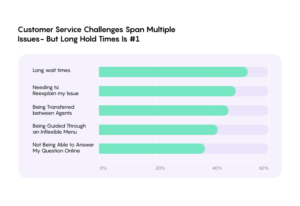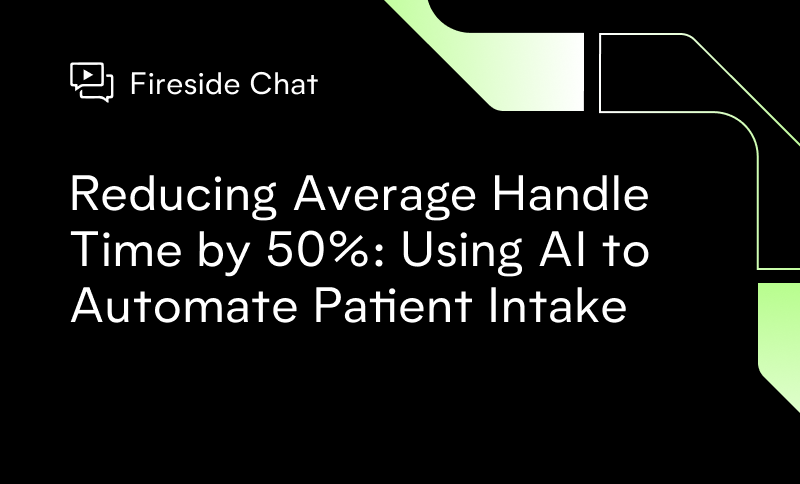Call routing vs. transcribing vs. conversational AI
Intelligent solutions in contact centers are nothing new. They’ve been used throughout the industry in some form for a while now, helping agents receive calls, matching customers to the right department, and making it easier to automate call transcription.
But as call volumes grow, customer expectations skyrocket, and hiring challenges persist, it’s never been more important for industry leaders to distinguish between the types of intelligence available in the market today.
Here’s a breakdown of three of the most impactful technologies commonly leveraged in call centers, from the traditional to the cutting edge.
Call Routing
What it does
The most common form of call center intelligence is very basic: routing solutions like interactive voice response (IVR) and frontend menus that transfer callers to applicable agents, deflect to other self-service resources, or attempt to contain calls with packaged answers to keyword-driven questions.
For example, in these instances, the customer might say they have a payment question, so the IVR routes them to the billing department, an online or app-based page, or attempts to answer the question itself.
Routing solutions like these replace older menu systems that asked callers to press “1” or “2” for select services, or flows that would autoplay long, rigid menus. Some routing solutions can even perform back-office functions like data entry and act as virtual agents for specific tasks.
Where it falls short:
What dates this form of “intelligence” is its user experience. The solution was initially designed to make the most of hold times and prevent agents from having to extract initial customer intents. Now, it often leads to frustrated callers.
In routing-oriented solutions, for example, an IVR may understand that a customer’s question can be resolved through the organization’s app. In response, it prompts the customer to open their smartphone’s app store, download an app, and create an account.
Aside from essentially creating four more steps for the customer, this solution doesn’t consider that the caller could have been driving during the call, or might not have a strong enough connection on their phone to download an app, leading to more rather than fewer inefficiencies.
What seemed to both the customer and IVR as a simple request now leaves the caller feeling like they’ve just wasted time by contacting customer service and can’t get answers through their preferred channel.
Conclusion:
Public expectations of human-to-machine interactions have changed. If the experience isn’t as simple as talking to their smartphone or at-home virtual assistant, brands are already fighting an uphill battle.
Transcription automation
What it does:
Call center conversations are often referred to as black boxes of data that industry leaders struggle to “open up” to leverage.
Transcription intelligence does the work of automatically putting these conversations into writing so they don’t gather dust in audio files. This unlocks customer interactions for fast, data-driven analysis.
Many legacy CCaaS providers have implemented transcription services as part of their core technology. This added layer brings the same technology built for personal solutions like countertop and smartphone assistants to the contact center. It adds greater visibility into contact center operations and customer data.
Where it falls short:
Transcription intelligence gets closer to modern AI solutions with a ubiquitous and effective solution for processing natural language. But the technology isn’t built for customer service specifically.
General transcription often struggles with names, alphanumeric strings, and numbers because it’s not advanced enough to handle complex, human-like conversations with a customer. In fact, these interactions aren’t expected to be necessary in the typical conversations that these transcription solutions are built for.
Many transcription bots can also be static, transcribing what they hear to the best of their ability without adding new intents, words, or synonyms to their dictionary. Inference accuracy and, by association, customer satisfaction, goes down the longer a bot stays online without improving.
Conclusion:
This is another stark example of the difference between the theoretical benefits of adding intelligence to contact centers and the actualized benefit of the technology. Leaders should look for intelligence solutions that improve agents’ toolsets and call centers’ data while also getting better with every call.
Conversational AI
What it does:
The third category of contact center intelligence is conversational AI which represents the cutting edge of industry technologies available today.
Conversational AI is artificial intelligence turned up to 100%. It can fully resolve customer requests without having to reroute calls. It can transcribe customer service-specific requests and also intelligently tag success rates. And it can distinguish multiple intents and dispositions in fractions of a second and self-improve with each interaction.
The technology has come a long way since its inception and adopters are seeing transformational changes not just in how their employees, phone systems, and data management work, but how customers, agents and internal systems come together to create efficiencies.
Where it stands out:
Practically, there’s a night and day difference between conversational AI and routing or transcription solutions. Gone are sentences like “If you’re calling to speak to X say or press Y,” replaced instead with a machine learning brain that instantly understands the difference between one intent, multiple intents, entities, and the relationships between them all.
A sentence like “I’d like to update my credit card, add a new address, and order a large pizza with pepperoni, olives, and gluten-free crust” can get a 100% accurate response from conversational AI without a delay. Call centers have identified this ability as a crucial benefit for customers.
Conversational AI transcription is also purpose-built for names, alphanumeric strings, email addresses, numbers, and other customer-specific interactions. It can accurately intake these items while performing precise entity extraction at the same time.
Finally, since conversational AI is purpose-built for contact centers, the solution is essentially ready for production when a call center purchases it. There’s no need to spend months or years perfecting a customized solution, or adding third-party AI on top of it.
Conclusion:
While this summary scratches the surface of conversational AI’s capabilities, the main takeaway should be this: the degree of intelligence directly impacts the user experience.
The same way that two websites built on the same platform can yield one extremely frustrating experience and one simple, elegant experience, conversational design can make or break a customer’s call.
The difference between solutions that have been around for years and conversational AI is that the former is built to bridge gaps and add marginal improvements to contact centers while the latter is designed to completely transform contact center and customer experiences.

 First Notice of Loss
First Notice of Loss 






